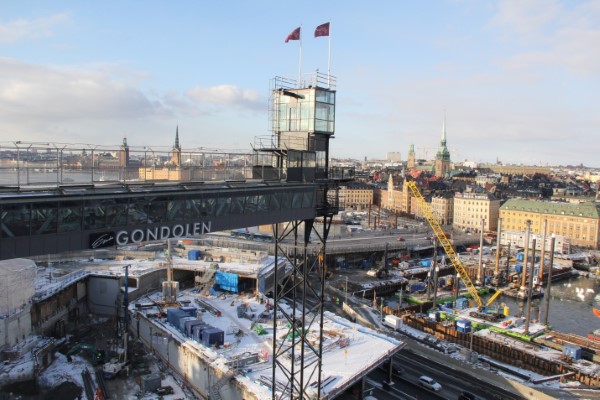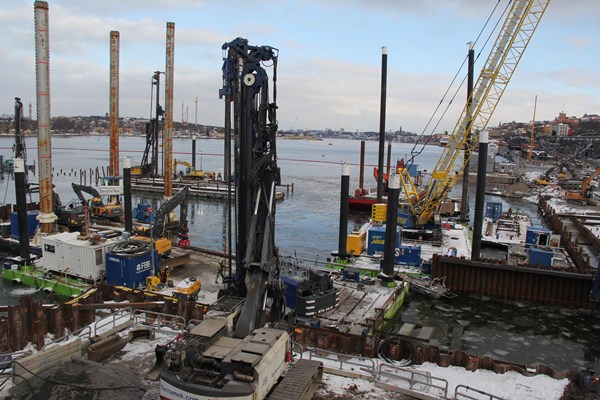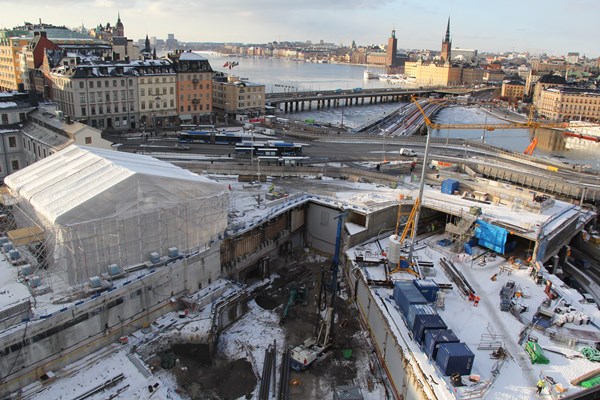Steel Pile News
3 000 piles will support the new Slussen in Stockholm for at least 100 years
March 20, 2018 14:07 CET 6 min read
Slussen, central hub in the City of Stockholm, is being reconstructed to become a vibrant meeting place with modern traffic solutions. After the modernization, Slussen will better cater for the needs of the Stockholmers. In the future there will be fewer cars in Slussen and it will become more effective and safer place for pedestrians, cyclists and public transport. It will also become one of Stockholm's most attractive meeting spots with cultural events, entertainment venues, parks, restaurants and cafes. Reconstruction will also secure clean drinking water since the drainage capacity will increase. Two million people get drinking water from Lake Mälaren, where there is a great risk of flooding due to having few outlets and limited drainage capacity into the sea. New Slussen will have a new lock channel and two new broad water discharge channels. This will make it possible to release 5 times as much water at Slussen as today.
Slussen is being reconstructed to become a vibrant meeting place with modern traffic solutions.
Slussen has been a lock between Södermalm and the Old Town in Stockholm. Since the first Slussen was built in 1642, it has been rebuilt and modernized several times. The current structure is the fourth Slussen and it was built in the 1930s but is now worn out. Last time when Slussen was built a new piling method, the Franki piling system or pressure-injected footing, was used. Unfortunately the sections of Slussen where it was used are among those that have sunk the most, up to 20 centimeters. In addition, porous concrete, which water can penetrate, was used. In the 1990s, it was determined that the entire Slussen structure was in poor condition. Slussen must be demolished and reconstructed from the scratch, because there are problems with the foundations, crumbling cement and rusting.
The area of Slussen has complex geology. It is 70 metres at most down to bedrock. And there are layers of the Stockholm Ridge and many centuries of filling material. There will be different types of piles used depending on ground conditions. A large number of test bores and several test pile installations have been taken place before the start of the project.
Skanska is one of the construction companies assisting the City of Stockholm with this massive project. Skanska Sweden is one of Sweden’s largest construction companies, with operations in building and civil-engineering construction. The contracts with Skanska are implemented in extended collaboration, so-called partnering. The reconstruction of Slussen has been divided into about 25 sub-projects and it will take several years to complete. Skanska has been assigned to the two largest projects as well as three others: a lock system with quays, engineering structures, main bridge over Söderström, drainage openings and traffic measures within the building site. The construction work started in summer 2016 and the contract will end in 2022. During the project it has been crucial for Skanska to have good communication with the residents. Daily traffic must function, since there is a huge amount of people passing through Slussen per day: 30 000 motorists, 60 000 city bus passengers, 70 000 Nacka/Värmdö bus passengers, 26 000 cyclists, 23 000 pedestrians and 270 000 subway passengers
Since the project started in 2016 SSAB has delivered in total 40 000 meters of piles, meaning 3 600 tons of steel, to Slussen. SSAB has already delivered 4 RD pile walls, in total 3 750 meters of RD400/12.5, 1 600 meters of RD320/12.5 and 850 meters of RD320/10, all equipped with RM/RF-interlocks welded at tube mill. This means 800 tons of SSAB steel for the retaining walls. All RD pile walls in this project are temporary structures.
SSAB has also delivered RD pile elements RD320/12.5 and RD220/12.5 in total over 700 meters, 50 tons and RR pile elements RR220/10 250 meters, 15 tons. Deliveries have also included close to 33 000 meters, 2 800 tons of RR piles in following dimensions: RR220/10, RR320/12.5, RR270/12.5, RR170/12.5 and RR170/10, RR400/12.5, RR500/14.2 and RR500/12.5. RR/RD400 and RR500 piles are spirally welded and manufactured at SSAB Oulainen mill. RR170 - RR320 piles are longitudinally welded and manufactured at SSAB Pulkkila mill. Steel grade for the piles is S460MH, expect for some RR piles and RD pile wall RD400/12.5 is S550J2H.
Since the project started in 2016 SSAB has delivered in total 40 000 meters of piles, meaning 3 600 tons of steel, to Slussen.
The challenge at the construction site is that due to the very central location in Stockholm there is no storage space. There is construction material only for 3 days need at the site. All the piles are delivered to the stocks in Bro or Södertälje. “We have been satisfied with the deliveries. On-time arrival notifications have been essential for the efficient planning of unloading.” says Magnus Silen, Purchasing Manager, Skanska. Due to the historical location between Gamla Stan and Södermalm, the job site is prepared for stoppages all the time since there are archeologists working continuously at the site. Ground conditions bring challenges in the form of the foundation depth and so-called old Slussen. This is the 5th time that Slussen is being built, which means that there are wooden piles and concrete elements in the ground.
The challenge at the construction site is that due to the very central location in Stockholm there can be stored construction material only for 3 days need at the site.


